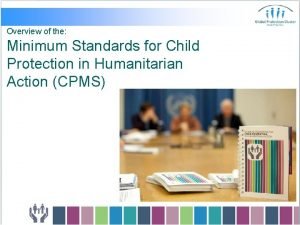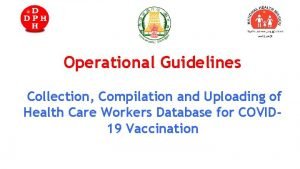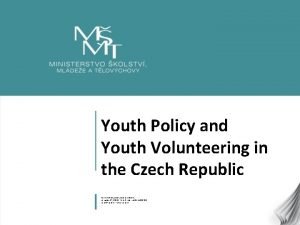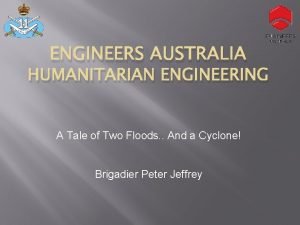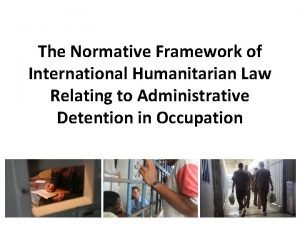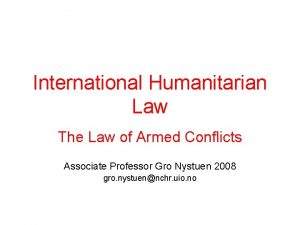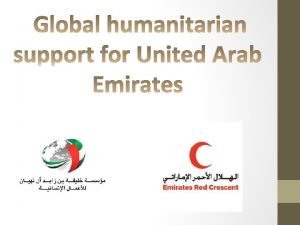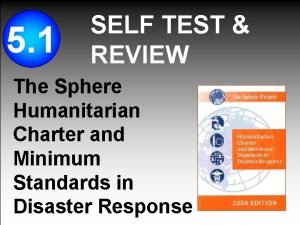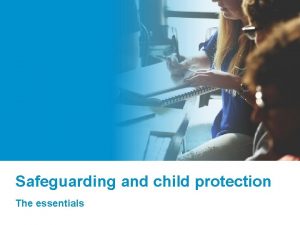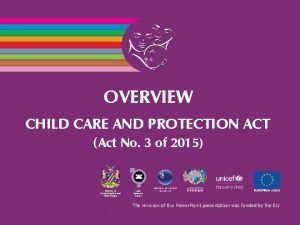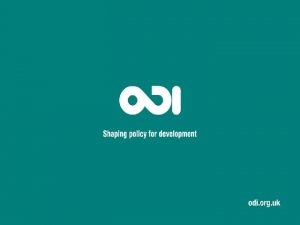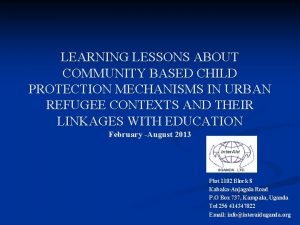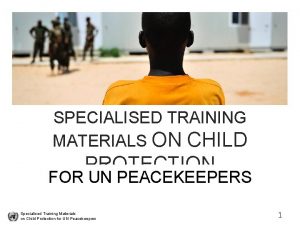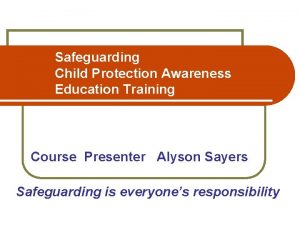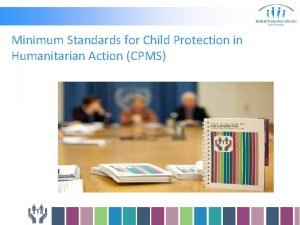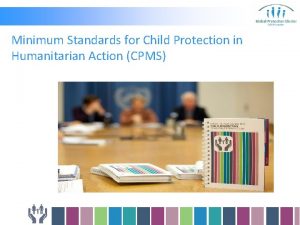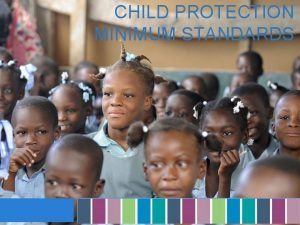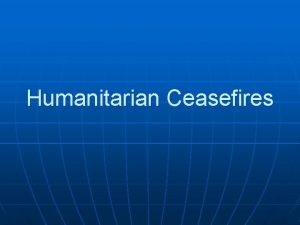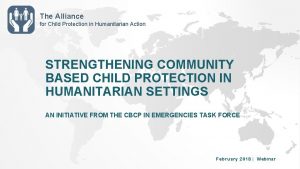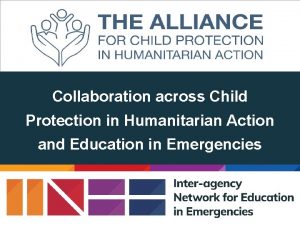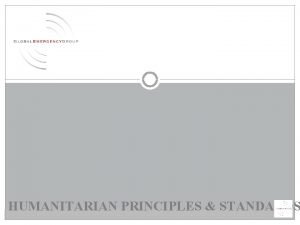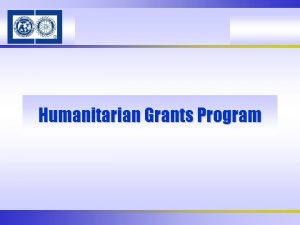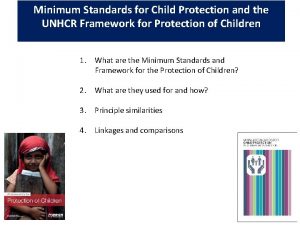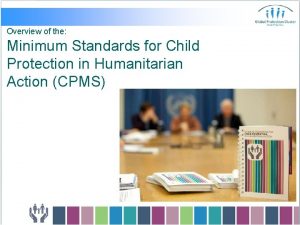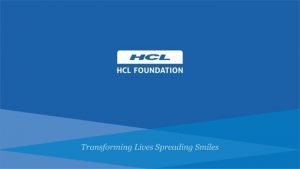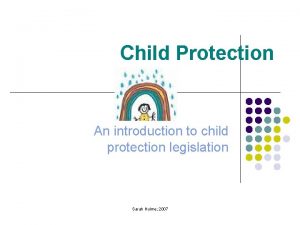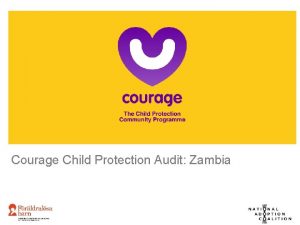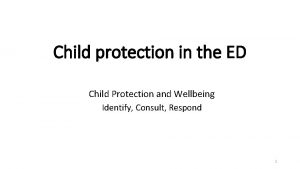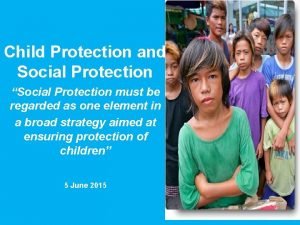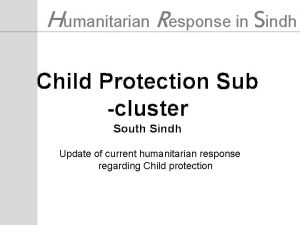Minimum Standards for Child Protection in Humanitarian Action





























- Slides: 29

Minimum Standards for Child Protection in Humanitarian Action (CPMS)

What was the need for Minimum Standards? “I have trouble convincing our manager and donor that child protection in emergencies can prevent violence and save lives” “We find it find hard to discuss the importance of child protection interventions with humanitarian workers in other sectors” “I spend a lot of time searching for the latest guidelines on child protection”

The Need for CP Minimum Standards …help organizations prepare for child protection issues during emergency response …provide benchmarks for what is a ‘good enough’ child protection programme …indicators would allow organizations to better evaluate their response work in terms of child protection …enable new cluster members at country level to benefit from evolution of the sector so far, and encourage all actors to obtain a minimum level of quality in responses

What is the goal of the CPMS? to improve programming and accountability in child protection work in emergencies

CPMS Objectives ² Establish common principles among those working in child protection; ² Improve the quality of child protection programming and its impact for children; ² Improve accountability within child protection work; ² Provide a synthesis of good practice and learning to date; ² Enable better advocacy and communication on child protection risks, needs and responses.

How were they developed? • 400+ people • 30 organizations • More that 40 countries worldwide • 16 country consultations • 8 pre-final drafts

What is a minimum standard? ² Agreed universal benchmark to be achieved or aspired to without being altered. ² A common agreement of what needs to be achieved and adequate quality. ² Some Standards will need to be prioritized or phased, depending on the starting point in the context. ² Some will not be relevant for a particular context.

Can we change them? Each Standard is universal – but as a team, you are encouraged to adapt the rest of the tool. This involves a process of debating, determining and agreeing upon the meaning of the global guidance in your context. Adapting the CPMS makes them more relevant, applicable and accessible for child protection actors, as well as for children and communities.

How is the CPMS handbook structured? At the core are the Principles & Approaches ² Background on CPi. E ² 26 Standards ² Glossary


Standards for a Quality Response 1. Coordination 2. Human resources 3. Communications, Advocacy and Media 4. Programme Cycle Management 5. Information Management 6. Child Protection Monitoring

Standards for Addressing Needs 7. Dangers and injuries 8. Physical violence & other harmful practices 9. Sexual violence 10. Psychosocial distress & mental disorders 11. Children associated with armed forces or groups 12. Child labour 13. Unaccompanied & separate children

Standards for Developing Adequate Strategies 15. Case Management 16. Community-based child protection mechanisms 17. Child-friendly spaces 18. Protecting excluded children

Standards for Mainstreaming 19. Economic Recovery 20. Education 21. Health 22. Nutrition 23. WASH 24. Shelter 25. Camp Management 26. Distribution and Child Protection

What is in a Standard? ² Background information ² Standard ² Key actions in preparedness & response phases ² Outcome & action indicators ² Guidance notes ² References

The CPMS & its Principles- Changing how we work “Sometimes our field staff are under enormous pressure to jump into responses without consulting existing actors and systems on the ground. CPMS Principle 5 really helped our colleagues to identify what was existing in the country as a child protection system: on the ground, in the community, in the government’s systems. ” Makiba Yamano, World Vision International


Who are they for? Government personnel and those working in independent or multilateral organizations Planners, policymakers and coordinators Those working directly with children, families and communities Donors Justice system & security personnel CPMS Armed forces & groups

Working alongside other humanitarian standards The Sphere Project, the ICRC Professional Standards for Protection, INEE Standards & others help humanitarian actors to improve quality and accountability. + In May 2013, the CPMS received companion status to the Sphere Standards.

When do we use them? Preparedness Prevention Response Early Recovery

To sum up, how can the CPMS be used? To plan and cost humanitarian interventions To agree common principles between different actors To monitor and evaluate the allocation of funding To hire, orient, induct and train new staff or partners To increase the effectiveness of humanitarian activities in other sectors To establish common and measurable expectations As a learning and reference document To improve advocacy and communications on child protection issues

Measurement and the CPMS

CPMS Help Measure Impacts There is a clear need to increase the sector’s effectiveness by producing a solid evidence base. The CPMS state how we measure the impact of our work and provide sample indicators.

Measuring Standard 6 – CP Monitoring 1. A common situation monitoring framework is in place, including indicators, data collection methods and frequency of data collection 2. The information included in the CP monitoring systems are disaggregated by age, sex, child protection concerns and location 3. Inter-agency incidents reporting is carried out on a monthly basis 4. Inter-agency “response monitoring” is carried out on a monthly basis through activity info 5. The members of the CP and GBV sector groups will report regularly on the indicators in the Regional Response Plan (RRP). Frequency Mid 2014 Source Yes Monthly Every third month reports Monthly reports RRP




A practical, interagency tool to address programming challenges. They are reshaping Child Protection in Emergencies worldwide.

The power of advocacy
 Child protection minimum standards
Child protection minimum standards Absolute maximum and minimum
Absolute maximum and minimum Ee.humanitarian response.info/x/vpdlixjf
Ee.humanitarian response.info/x/vpdlixjf Humanitarian work psychology
Humanitarian work psychology Humanitarian projects in prague for youth
Humanitarian projects in prague for youth Humanitarian
Humanitarian Humanitarian programme cycle 2021
Humanitarian programme cycle 2021 Afjrotc awards and decorations
Afjrotc awards and decorations Afjrotc distinguished cadet badge
Afjrotc distinguished cadet badge Humanitarian engineers in cape york
Humanitarian engineers in cape york International humanitarian law icrc
International humanitarian law icrc International humanitarian law icrc
International humanitarian law icrc Ihl
Ihl Khalifa humanitarian foundation
Khalifa humanitarian foundation Domistan
Domistan Humanitarian work psychology
Humanitarian work psychology Minimum standards test writing
Minimum standards test writing Safeguarding and child protection the essentials
Safeguarding and child protection the essentials Courage child protection
Courage child protection Opinyon tungkol sa child protection policy
Opinyon tungkol sa child protection policy Rights and responsibilities of a child at school
Rights and responsibilities of a child at school Types of child protection
Types of child protection Child protection case management tools
Child protection case management tools Types of child protection
Types of child protection Child protection and toy safety act
Child protection and toy safety act Professional curiosity in nursing
Professional curiosity in nursing Community based child protection mechanisms
Community based child protection mechanisms Child care and protection act 3 of 2015
Child care and protection act 3 of 2015 Child protection training materials
Child protection training materials Child protection awareness training
Child protection awareness training
